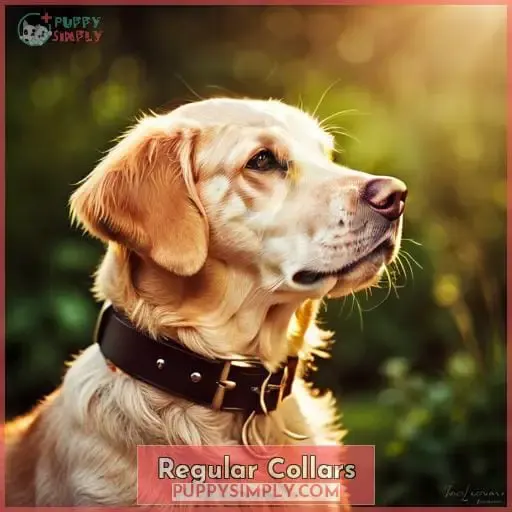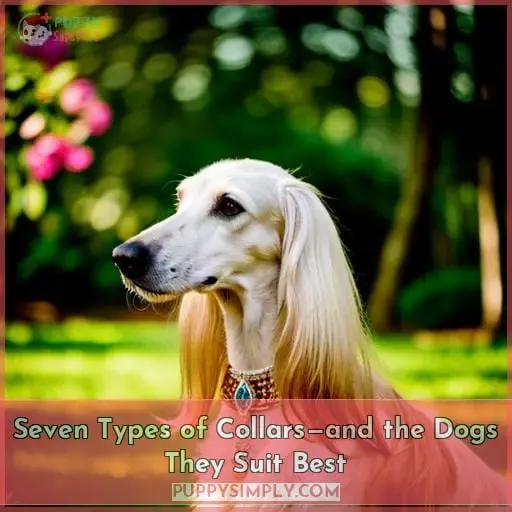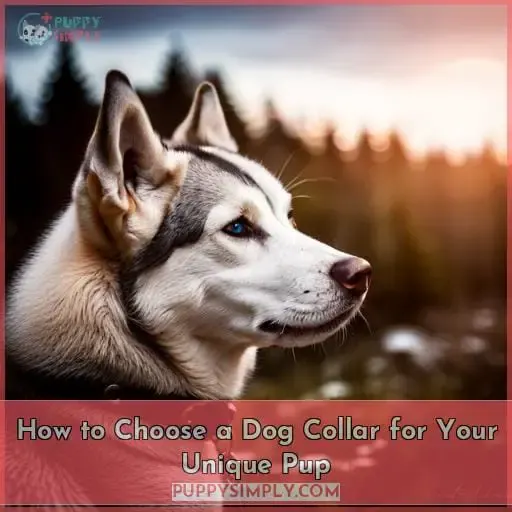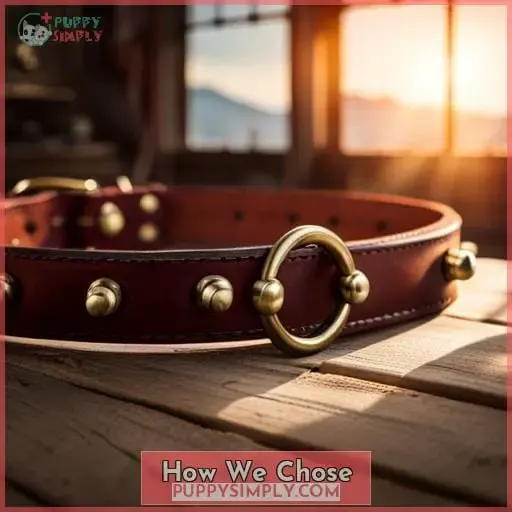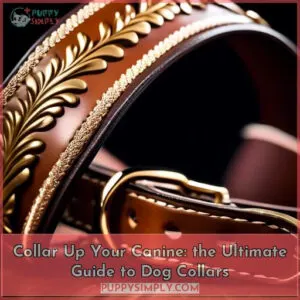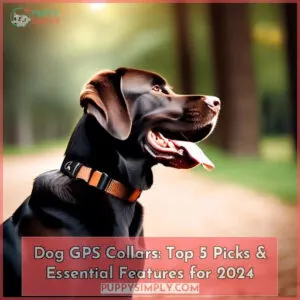This site is supported by our readers. We may earn a commission, at no cost to you, if you purchase through links.
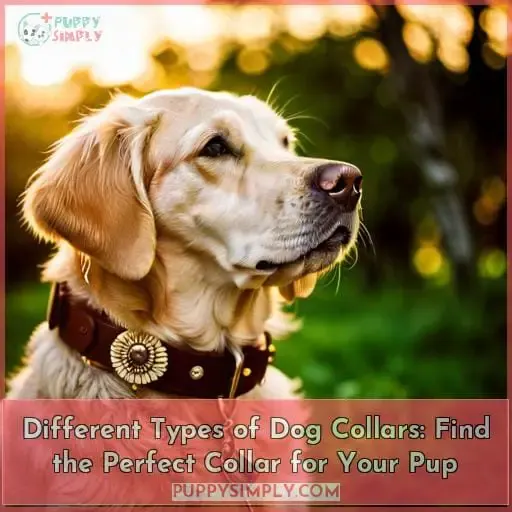 Picture this:
Picture this:
You’re taking your furry friend for a walk, but their collar is uncomfortable and doesn’t fit quite right.
Sound familiar?
Don’t worry, we’ve got you covered.
In this article, we’ll explore the different types of dog collars so you can find the perfect one for your pup.
From flat collars to martingale collars and everything in between, we’ll provide all the information you need to make an informed decision and give your dog the comfort they deserve.
Let’s get started!
Table Of Contents
- Key Takeaways
- Regular Collars
- Seven Types of Collars—and the Dogs They Suit Best
- How to Choose a Dog Collar for Your Unique Pup
- Brandon McMillan
- How We Chose
- Frequently Asked Questions (FAQs)
- What materials are best for dogs with skin allergies or sensitivities?
- How often should I check my dog’s collar for wear and tear?
- Are GPS or Bluetooth tracking collars safe for my dog to wear?
- What type of collar is easiest to clean for dogs who play in mud or water frequently?
- Do I need to use a different collar if my dog pulls strongly during walks?
- Conclusion
Key Takeaways
- Different types of dog collars serve specific purposes, such as regular collars, martingale collars, head collars, and personalized collars.
- There are various collar options suitable for different breeds, including flat collars, waterproof rubber collars, leather collars, and GPS or smart collars.
- It is important to choose a collar that meets the specific needs of your dog, such as using a head collar for pulling dogs, XL collars for big or powerful dogs, adjustable collars for growing puppies, and training collars for dogs in training.
- Brandon McMillan’s training approach focuses on positive reinforcement, trust-building, and establishing a strong bond with your dog to address behavioral challenges.
Regular Collars
When it comes to regular collars for your dog, there are a few options that you can consider.
The most common type is the flat collar, which is made of materials like nylon, rubber, or leather and typically features a buckle or quick-release closure.
Another option is the martingale collar, which is designed for dogs with narrow heads and prevents slipping out without choking.
Lastly, there’s the head collar that sits high on the head and helps control strong dogs prone to pulling by reducing leverage.
Each type has its own benefits and considerations to keep in mind when choosing one for your pup.
Flat Collar
If you’re looking for a simple and versatile option, the flat collar is the go-to choice for most dog owners.
It’s made of nylon, rubber, or leather and comes in various colors and designs for personalization.
When selecting a flat collar, it’s important to consider proper sizing tips to ensure a comfortable fit.
Additionally, DIY personalization can be added with name tags or custom engravings.
Remember to prioritize safety measures by choosing durable materials and secure clasp options that won’t easily break or open during walks.
Martingale Collar
Choose a martingale collar for your dog if you need a secure and humane option that prevents slipping out. These collars are designed to tighten when the dog pulls, providing control without choking.
Here’s why martingale collars are worth considering:
- Safety Measures: Prevents escape artists from slipping out of their collar.
- Training Techniques: Ideal for behavioral adaptation during training sessions.
- Breed Suitability: Particularly suitable for narrow-headed breeds like Greyhounds and Whippets
Head Collar
To ensure effective leash training and behavior control for your energetic pup, consider using a head collar.
This type of collar acts like a harness for the head, reducing pressure on the trachea.
When fitting your dog with a head collar, make sure it sits high on the head behind the ears and forms a loop around the muzzle.
Remember to use positive reinforcement techniques during training and never leave your dog unattended or on long leads while wearing a head collar.
Seven Types of Collars—and the Dogs They Suit Best
You’ll discover that different dog breeds and temperaments often do best with certain types of collars.
As examples, escape artists and sight hounds tend to benefit from martingale collars, while GPS and smart collars can provide useful location tracking or training features for some pups.
Selecting the optimal collar style for your dog’s needs and personality helps ensure safety, effective training, and comfort during daily walks.
Flat Collars Are a Comfortable Nylon Default
You’ll love the comfort and versatility of flat collars, which are a popular choice for many dog owners.
These nylon default collars offer customization options with trendy designs to suit your pup’s style.
They provide safety measures with their sturdy construction and secure buckle closures.
Alternative materials like rubber or leather can also be used for added durability and aesthetic appeal.
Consider your dog’s size when selecting a regular collar that ensures both comfort and control during walks or outings in style.
Waterproof Rubber Collars Dry Fast and Repel Odors
When it comes to practicality and convenience, waterproof rubber collars are an excellent choice for dog owners who want a collar that dries quickly and repels odors.
Made from odor-resistant materials, these fast-drying collars offer waterproof options that are perfect for active dogs who love water activities.
The practicality of rubber makes maintenance easy as well. Simply rinse with water or wipe clean to keep the collar looking fresh and smelling great after every adventure with your furry friend.
Leather Collars Are Classy, Durable, and Sometimes Pricey
Choose a leather collar for your pup if you’re looking for a classy, durable option that may come with a higher price tag.
Leather collars exude an air of elegance and sophistication while offering long-lasting durability.
These fashionable canine accessories are available in various styles and colors, allowing for customization options to suit your dog’s unique personality.
When choosing quality leather collars, consider factors like size, comfort, and the specific needs of sighthound breeds or dogs prone to slipping out of their collars.
- Classy Elegance
- Durability vs. Price
- Fashionable Canine Accessories
- Customization Options
Martingale Collars Are for Escape Artists and Sight Hounds
For dogs with narrow heads or who slip out of regular collars, you’re wise to turn to martingale collars. These unique collars are specifically designed for escape prevention and safety measures.
The limited-slip design ensures control without choking the dog, making them a perfect solution for dogs prone to slipping out of traditional collars. Proper fitting and training techniques can ensure effective use of the martingale collar during leash walks while providing peace of mind for owners.
GPS and Smart Collars Can Offer Peace of Mind
With GPS and smart collars, you can have peace of mind knowing the exact location and behavior of your dog.
These innovative collars offer a range of benefits, including:
- Location tracking for easy retrieval if your pup wanders off.
- Training tech advancements that assist in leash training and behavior control.
Smart collars provide enhanced safety compared to traditional options by offering real-time monitoring capabilities.
Embrace the power of canine wearable tech with these smart collar options.
How to Choose a Dog Collar for Your Unique Pup
When choosing a dog collar for your unique pup, there are several factors to consider.
- If you have a dog who pulls, opt for a head collar or harness that minimizes strain on the neck.
- For especially big or powerful dogs, look for sturdy materials like leather and strong buckle closures.
- Growing puppies may benefit from adjustable collars that can accommodate their changing size.
- Dogs in training might require specialized training collars designed to aid in behavior control and leash guidance.
- And if you have a sighthound or slim-necked breed, martingale collars offer both security and comfort without choking hazards.
I Have a Dog Who Pulls
Another great option for your energetic puller is a head collar, which gently discourages pulling by redirecting their head towards you when tension is applied, while avoiding injury.
Head collars steer via the muzzle for leash training, enabling gentle steering without choking.
As pulling solutions that emphasize positive reinforcement and safety measures, head collars suit energetic dogs needing extra control.
I Have an Especially Big or Powerful Dog
If you have an especially big or powerful dog, it’s important to choose a dog collar that can withstand their strength and size.
Power breeds require robust canine solutions to ensure both control and comfort during walks.
Consider XL dog collars made specifically for strong dogs.
Strength training collars can also be beneficial for teaching good leash manners to your mighty pup.
Look for high-quality, durable materials when selecting mighty pup accessories from reputable pet gear brands.
I Have a Growing Puppy
When choosing a collar for your growing pup, you’ll want to pick one with adjustable sizing that accommodates growth.
Prioritize collars made of puppy-friendly materials like nylon or leather.
As your puppy grows, routinely check that the collar still fits properly – snug enough not to slip off, but loose enough for comfort.
Use positive reinforcement training tips tailored for puppies to teach good leash habits from the start.
Gradually move up collar sizes to ensure both safety and security as your puppy matures.
I Have a Dog in Training
Since you have a dog in training, a training collar designed to aid behavioral corrections may be the best option.
- Head halter for pull correction
- Martingale collar for leash pressure
- Treats for positive reinforcement
I Have a Sighthound or Slim-necked Breed
For owners of sighthounds or dogs with slim necks, choosing the right collar is essential to ensure comfort and safety.
Sighthounds and slim-necked breeds like Greyhounds and Whippets often slip out of regular collars.
Opt for martingale collars designed specifically for these breeds—the limited-slip functionality allows control without choking while preventing escape.
Well-fitted martingale collars in fashionable styles keep sighthounds like Greyhounds and Whippets safe on walks.
When training sighthounds, couple martingale collars with positive reinforcement for best results.
Brandon McMillan
Now that you have a better understanding of how to choose the right collar for your unique pup, let’s introduce you to an expert in training techniques and canine communication: Brandon McMillan.
As an animal trainer with years of experience, Brandon has developed a simple yet effective training system that focuses on building trust and control with your dog. His approach incorporates positive reinforcement and addresses common behavioral challenges through proper canine enrichment.
By following his guidance, you can gain the knowledge and skills necessary to establish a strong bond with your furry companion while effectively addressing any obedience or behavior issues.
To learn more about Brandon McMillan’s teachings, explore the class link provided in this article for exclusive access to his instructional videos and unlock the potential of your four-legged friend.
How We Chose
Find the Perfect Collar for Your Pup’:
When selecting a collar for your dog, you’ll want to consider factors like comfort, safety, and effectiveness for training.
The right collar depends on your pup’s breed, size, age, and temperament – a harness may suit a small dog better, while a martingale collar works for narrow heads.
You can match your dog’s personality as well with colorful designs, but be mindful of proper fit and intended use when making your choice.
Choosing the Right Collar
To choose the right collar for your pup, you need to consider various factors that will ensure their comfort and safety.
- Sizing Sensitivity:
- Measure your dog’s neck accurately and choose a collar that fits snugly but allows room for a finger underneath.
- Material Matters:
- Consider factors like durability, ease of cleaning, and whether your dog has any allergies or sensitivities.
- Training Tips:
- Depending on your training goals, certain collars may be more effective in aiding behavior correction or leash control.
Different Collar Types
To help you make an informed decision, we’ve carefully selected a range of different collar types that cater to various needs and preferences for your pup.
From fashionable flat collars to advanced technology collars with GPS tracking and behavior monitoring features, there’s something for every dog owner.
We also provide training tips and safety measures to ensure the well-being of your furry friend.
Personalized choices are available in terms of material, style, and design.
Embrace the power of choice when it comes to selecting the perfect collar for your pup’s liberation and control.
Considerations for Dog Comfort
You’ll want to factor in several elements when finding the right collar to keep your dog comfortable.
Prioritize comfort fit and adapt training to smooth adaptation.
Carefully select materials minimizing irritation while maximizing durability and breathability.
Follow precise fitting guidelines ensuring two fingers slip underneath, and implement safety measures like quick-release closures.
Adjust style and function based on your dog’s unique needs and limitations.
Frequently Asked Questions (FAQs)
What materials are best for dogs with skin allergies or sensitivities?
For dogs with skin allergies or sensitivities, it’s best to opt for collars made of hypoallergenic materials such as organic cotton or silicone.
These materials are gentle on the skin and reduce the risk of irritation.
How often should I check my dog’s collar for wear and tear?
Checking your dog’s collar for wear and tear is essential to ensure their safety.
How often should you do it?
Regularly inspect the collar for any signs of damage, such as fraying or loose hardware, to prevent accidents during walks.
Are GPS or Bluetooth tracking collars safe for my dog to wear?
GPS or Bluetooth tracking collars are generally safe for dogs to wear.
They provide real-time location monitoring, which enhances your control and power over their safety.
However, ensure the collar is comfortable and secure to avoid any potential harm or discomfort.
What type of collar is easiest to clean for dogs who play in mud or water frequently?
When playing in mud, a quick-dry nylon collar is easiest to rinse off.
Focus on regular cleaning to prevent skin irritation.
Choose wider styles to better distribute pressure.
Prioritize comfort, adjustability and safety.
Do I need to use a different collar if my dog pulls strongly during walks?
For strong pullers during walks, a head collar can provide better control and prevent strain on the neck.
Make sure to properly fit and introduce it to your dog for safe use.
Conclusion
Tracking the trends, types rule when finding Fido’s fabulous, friction-free neckwear.
From flat to martingale collars, prioritizing your pup’s comfort caters to canine contentment.
Thoughtfully taking measurements, minding materials, and noting neck shape steers you towards the tailored type of dog collar suiting your special sidekick.
Now you’re set to select the stellar, scratch-free style securing satisfaction for your sweet hound.

